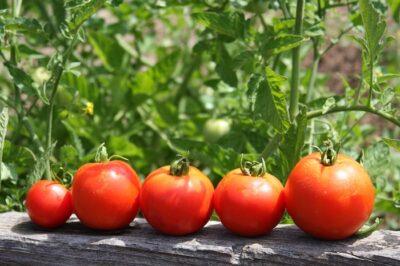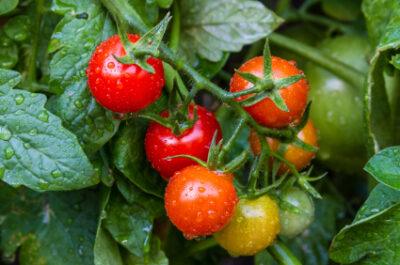
Image source: lettucebehealthy.net
In a new series of articles, we will be featuring some of the most common (and maybe a few not so common) garden vegetables and how you can get the most bountiful harvest of them in your garden. And for our first featured veggie, we decided to go with what is perhaps the most popular amongst gardeners – the tomato.
Fruit or Vegetable?
Technically – botanically – a tomato is a fruit. In fact, so are many of the so-called “veggies” that we gardeners enjoy growing.
Politically however, it’s a different story. In 1893, the Supreme Court ruled the tomato a vegetable in order to be able to levy duties on imported tomatoes as “foreign vegetables.” In subsequent years, other produce which are technically fruit were also “ruled” vegetables. Oddly, rhubarb – a vegetable – was ruled to be a fruit. Weird, huh?
Tomato Varieties
If you’ve been to a nursery lately, you have probably seen a dozen or more varieties of tomato plants available. But did you know that according to the US Department of Agriculture, there are more than 25,000 varieties of tomatoes?
Tomatoes come in many different sizes and colors, from bright red, to orange and yellow – even purple! They range from meaty to juicy and from sweet to tart.
So how do you choose what to plant? You must first consider how much space you have to grow them and what your climate is like. Different tomatoes will do better in different environments. Check to see what varieties your local nursery is selling, as this will give you a good indication of what might work for your area and do a bit of reading on the variety you are considering.
The Best Source For Tomato Heirloom Seeds Is Right Here!
If your area has been struck with common tomato diseases in the last few years – such as late blight or root-knot nematode, you may also want to choose a variety that has some resistance to these problems.
Starting Your Seeds
If you are starting your tomatoes from seeds, you’ll get best results from starting them indoors approximately 6-8 weeks before the last frost. Seeds should be planted in moist, sterile seed-starting soil about ¼ inch deep.
Keep young seedlings under a grow light or in a south-facing window.
Moving Them Outside
 Once the weather is warm enough, begin hardening off the seedlings by putting them outside for increasingly longer periods of time. This will help get them used to factors like changes in temperature, direct sunlight and wind before they are finally transplanted into your garden.
Once the weather is warm enough, begin hardening off the seedlings by putting them outside for increasingly longer periods of time. This will help get them used to factors like changes in temperature, direct sunlight and wind before they are finally transplanted into your garden.
After all danger of frost has passed, it is time to move your tomatoes to their new home in your garden. Select a spot that gets at least 10 hours a day of sunlight and make sure you plant them far enough apart that there is plenty of room for air circulation.
Also, try not to plant them in the same spot every year, as this will increase the risk for disease to the plant.
Caring For Your Tomatoes
Tomatoes are not difficult to care for, but there are some tips that you should remember in order to help keep your plants healthy and ensure a bountiful harvest.
- Watering – tomatoes do not need to be watered every day, but when you do water them make sure you give them plenty to drink. Water at the base of the stem and never on top of the leaves.
- Staking – Many tomato plants get very heavy with fruit and need extra support to keep them from breaking. Use tomato cages or stakes at the time of transplant. Do some research ahead of time on the variety you have planted to ensure you are staking them high enough. Some varieties – such as “Brandywine” — should have six-foot-high stakes!
- Pinching – If you want your plant to grow bigger and more numerous fruit, be sure to pinch off any non-fruiting branches.
- Composting and trimming – encourage growth by adding compost around the base of the stem as the first fruits are ripening. Trimming the upper leaves will also help to simulate growth.
- Harvesting – there is nothing like vine-ripened tomatoes, so let them get fully mature before you harvest. If you’ve still got green tomatoes when the weather starts to turn cold, however, you can pick them green and let them ripen indoors.
Tomato Troubleshooting
There are several reasons why a tomato crop might fail or not yield the desired results, but diligent monitoring and troubleshooting – not to mention a healthy dose of preventative maintenance — can often nip these problems in the bud.
The Secrets Of Sea Minerals To Grow More “Nutritionally-Dense Food” Than You Can Possibly Eat!
Common problems and their solutions include:
- Phosphorus deficiency (characterized by purple veined leaves and absence of insects) – use mulch to warm the soil.
- Curly top virus (characterized by plants turning yellow) – use row covers to protect plants from leafhoppers.
- Hornworms (large green caterpillars) – pick off by hand.
- Early or late blight (fungus which destroys leaves and fruit) – use good sanitation, keep area clear of plant debris and rotate crops each year. (Read Off The Grid News’ story on late blight.)
- Whiteflies and aphids – protect plants with a soapy water mixture and/or use companion plants that discourage these pests.
For many home gardeners, tomatoes are a must-have item in their garden and it is easy to see why. From fresh salads, homemade sauces and even jams – they are versatile and delicious. And while starting, caring for and troubleshooting these plants does take a bit of work, the results are well worth it!
What tomato tips would you add? Share your suggestions in the section below:
Do You Know The Biggest Mistake Gardeners Will Make This Year? Read More Here.
 Off The Grid News Better Ideas For Off The Grid Living
Off The Grid News Better Ideas For Off The Grid Living



